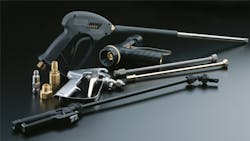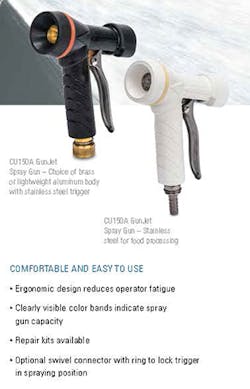One Simple Trick to Cut Industrial Water Usage in Half
In the food processing business, water is the secret ingredient.
Between cleaning, heat transfer, sanitation, and processing applications, the food industry uses about 0.26 gallons of water to produce just one calorie consumed of food.
Multiply that out, and your 500 calorie lunch used about 130 gallons of water before it even reached the kitchen.
When you break these consumption numbers down across the rest of the industrial sector, the manufacturing industry seems to be using a disproportionate share of the U.S. fresh water supply.
According to a new whitepaper published by Spraying Systems Co., manufacturers use about 45% of the country's fresh water, while only 18% goes for domestic use.
In manufacturing and processing industries where costs and conservation are paramount, the heavy usage recorded in these figures should strike you as a little odd.
"For example, there's a mindset in the food processing industry that, when in doubt, use more water," explains Tim Oberg, industrial division director at Spraying Systems Co.
"If you're not sure it's clean, if you're not sure it's sanitized, just use more water," he explains. "I mean, it's just water; it's cheap, right?"
Well, not really, he says.
The cost of water itself is on the rise—up 7.3% in the last year and up nearly 30% since 2003. But, of course, water is only one part of the overall cost of consumption.
"In addition to water itself, you have to consider chemical usage, and then the energy used to heat it, and then treatment and disposal," Oberg explains. "Combine all of those together, and you start talking about some serious costs."
Open-hose systems can flow in excess of 20 gallons per minute out of every hose—often more than twice the amount that's actually needed.
In his position at Spraying Systems Co., Oberg is on the front line to help customers reign in those costs and, along the way, bring down the industry's share of the fresh water use.
He does this through a service provided by Spraying Systems Co. that sends local sales engineers into plants around the country for a free top-to-bottom water usage assessment.
During these assessments, Oberg and his team uncover a wide range of issues and mindsets regarding water usage, working with sophisticated plants that provide years of water bills and usage records and others that can't even locate their water meter.
But what surprises Oberg the most in this experience, he says, are the simplest things plants haven't done to shore up water flow.
"One of the things I am always struck by in a food plant is the number of open hoses I see," he explains. "You'll just have a ball valve on the end of a hose functioning as a spray gun, and it's just wide open."
He sees this as part of the "when in doubt, use more water" mindset, but taken to the extreme.
"They think, 'I'm not just going to wash down everything,'" he says. "'I'm going to flood it.'"
These open-hose systems can flow in excess of 20 gallons per minute out of every hose—often more than twice the amount that's actually needed.
To illustrate the waste the produces, Oberg points to a study published in the whitepaper about a turkey processing plant that participated in Spraying Systems Co.'s water assessment program.
Before the assessment, the plant was using 15 open-end sanitation hoses spraying eight hours a day, five days a week, 50 weeks a year.
That adds up to about 125 million gallons of hot water consumed every year.
"Operators sometimes tend to 'accidentally' lose new spray guns," Oberg explains. "They really like using the wide open hose and ball valve. They like the feel of it; they're used to it."
That—plus a little training—did the trick.
With nothing more than a dozen or so spray guns, the plant brought its daily water consumption down by over 17,000 gallons per day.
Annualized, that means saving over 4 million gallons of water, plus all of the heating, chemical, and disposal costs it includes.
Altogether, that translated to an annual savings of over $30,000—a salary's worth of saving for the cost of 15 spray guns.
Read Spraying Systems Co.'s full report, Change the Way You Spray to Maximize Water Conservation.
About the Author
Travis Hessman
VP of Content, Endeavor Business Media
Travis Hessman is the VP of Content for Endeavor Business Media. Previously, Travis was the Editor-in-Chief for Industry Week and New Equipment Digest as well as the Group Editorial Director for Endeavor's Manufacturing Group.
He began his career as an intern at IndustryWeek in 2001 and later served as IW's technology and innovation editor. Today, he combines his experience as an educator, a writer, and a journalist to help address some of the most significant challenges in the manufacturing industry, with a particular focus on leadership, training, and the technologies of smart manufacturing.



